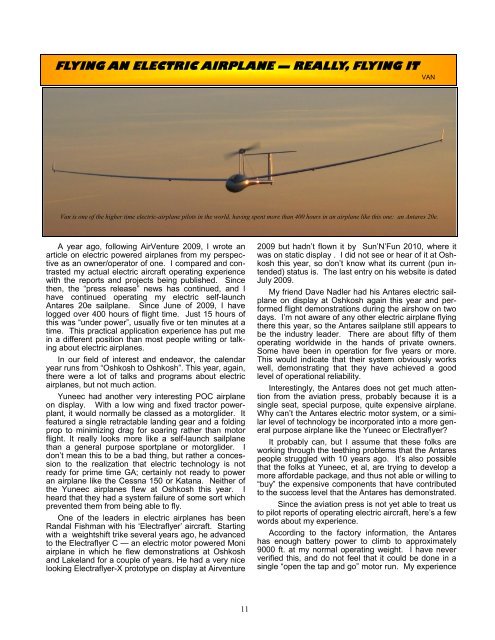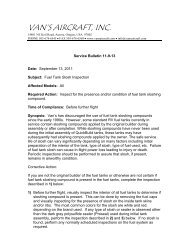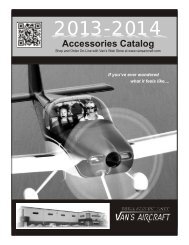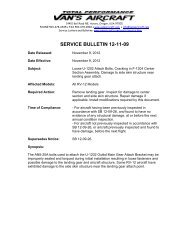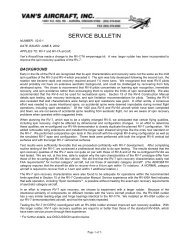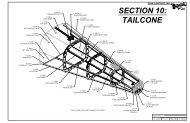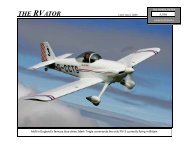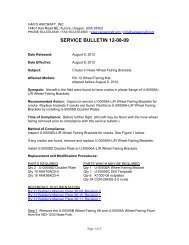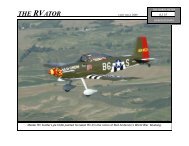Create successful ePaper yourself
Turn your PDF publications into a flip-book with our unique Google optimized e-Paper software.
FLYING AN ELECTRIC AIRPLANE — REALLY, FLYING IT<br />
Van is one of the higher time electric-airplane pilots in the world, having spent more than 400 hours in an airplane like this one: an Antares 20e.<br />
A year ago, following AirVenture 2009, I wrote an<br />
article on electric powered airplanes from my perspective<br />
as an owner/operator of one. I compared and contrasted<br />
my actual electric aircraft operating experience<br />
with the reports and projects being published. Since<br />
then, the “press release” news has continued, and I<br />
have continued operating my electric self-launch<br />
Antares 20e sailplane. Since June of 2009, I have<br />
logged over 400 hours of flight time. Just 15 hours of<br />
this was “under power”, usually five or ten minutes at a<br />
time. This practical application experience has put me<br />
in a different position than most people writing or talking<br />
about electric airplanes.<br />
In our field of interest and endeavor, the calendar<br />
year runs from “Oshkosh to Oshkosh”. This year, again,<br />
there were a lot of talks and programs about electric<br />
airplanes, but not much action.<br />
Yuneec had another very interesting POC airplane<br />
on display. With a low wing and fixed tractor powerplant,<br />
it would normally be classed as a motorglider. It<br />
featured a single retractable landing gear and a folding<br />
prop to minimizing drag for soaring rather than motor<br />
flight. It really looks more like a self-launch sailplane<br />
than a general purpose sportplane or motorglider. I<br />
don’t mean this to be a bad thing, but rather a concession<br />
to the realization that electric technology is not<br />
ready for prime time GA; certainly not ready to power<br />
an airplane like the Cessna 150 or Katana. Neither of<br />
the Yuneec airplanes flew at Oshkosh this year. I<br />
heard that they had a system failure of some sort which<br />
prevented them from being able to fly.<br />
One of the leaders in electric airplanes has been<br />
Randal Fishman with his ‘Electraflyer’ aircraft. Starting<br />
with a weightshift trike several years ago, he advanced<br />
to the Electraflyer C — an electric motor powered Moni<br />
airplane in which he flew demonstrations at Oshkosh<br />
and Lakeland for a couple of years. He had a very nice<br />
looking Electraflyer-X prototype on display at Airventure<br />
11<br />
VAN<br />
2009 but hadn’t flown it by Sun’N’Fun 2010, where it<br />
was on static display . I did not see or hear of it at Oshkosh<br />
this year, so don’t know what its current (pun intended)<br />
status is. The last entry on his website is dated<br />
July 2009.<br />
My friend Dave Nadler had his Antares electric sailplane<br />
on display at Oshkosh again this year and performed<br />
flight demonstrations during the airshow on two<br />
days. I’m not aware of any other electric airplane flying<br />
there this year, so the Antares sailplane still appears to<br />
be the industry leader. There are about fifty of them<br />
operating worldwide in the hands of private owners.<br />
Some have been in operation for five years or more.<br />
This would indicate that their system obviously works<br />
well, demonstrating that they have achieved a good<br />
level of operational reliability.<br />
Interestingly, the Antares does not get much attention<br />
from the aviation press, probably because it is a<br />
single seat, special purpose, quite expensive airplane.<br />
Why can’t the Antares electric motor system, or a similar<br />
level of technology be incorporated into a more general<br />
purpose airplane like the Yuneec or Electraflyer?<br />
It probably can, but I assume that these folks are<br />
working through the teething problems that the Antares<br />
people struggled with 10 years ago. It’s also possible<br />
that the folks at Yuneec, et al, are trying to develop a<br />
more affordable package, and thus not able or willing to<br />
“buy” the expensive components that have contributed<br />
to the success level that the Antares has demonstrated.<br />
Since the aviation press is not yet able to treat us<br />
to pilot reports of operating electric aircraft, here’s a few<br />
words about my experience.<br />
According to the factory information, the Antares<br />
has enough battery power to climb to approximately<br />
9000 ft. at my normal operating weight. I have never<br />
verified this, and do not feel that it could be done in a<br />
single “open the tap and go” motor run. My experience


